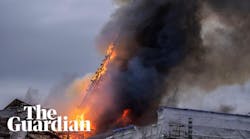On Thursday, Oct. 30, 2008, a three-alarm fire destroyed a historic 107-year-old textile mill in Columbus, GA. Firefighters encountered a large fire in an unoccupied building that was rapidly spreading throughout the structure. High winds were spreading embers for nearly five miles from the fire scene. Due to the size of the structure and the surrounding terrain, positioning apparatus in the best locations for fighting the fire was challenging.
The original mill was constructed in 1900 with additions built in 1916 and 1920. The four-story brick and heavy-timber mill was 1,060 feet long and 122 feet wide, encompassing over 750,000 square feet. Each floor was 16 feet high. The wood-truss roof was covered with two-inch-thick tongue-and-groove lumber covered with many layers of tar and insulation. The mill contained a wet pipe automatic sprinkler system on the fourth floor and horn and strobe pull stations throughout the building. The mill closed operations in 1998 and in 1999 an individual purchased the building with plans to convert it into a 140-room riverfront hotel and restaurant. A portion of the mill was also scheduled to be demolished. A mixed-use development of retail shops and residences was also planned.
Initial Dispatch
The Columbus Department of Fire and Emergency Medical Service was dispatched to a reported fire at the Bibb Mill on First Avenue at 12:20 A.M. Responding on the first alarm were Engine 1, a 1,500-gpm pumper; Engine 2, a 1,250-gpm pumper; Ladder 1, a 100-foot aerial ladder with a 2,000-gpm pump; Squad 6, a heavy rescue; and Medic 1 with 17 fire and EMS personnel under the command of Battalion 1 Chief Terry Herring.
First-arriving units found heavy smoke and fire coming from the northwest side of the building. Defensive operations were initiated immediately. Exposure protection and evacuation of two residential structures on the southeast side of the mill were necessary due to exposure problems and flying embers. Engine 1 was positioned near the center of the building on the north side and was supplied by a 300-foot, five-inch line. Firefighters deployed two 1¾-inch lines to protect an adjacent office building. Engine 2 laid a 500-foot, five-inch line to the northwest corner of the building. Ladder 1 was also positioned at the northwest corner and set up for aerial master stream operations. Engine 2 supplied Ladder 1 with a 300-foot, five-inch supply line. Firefighters advanced two, 200-foot, 1¾-inch attack lines into the interior of the River Mill to prevent fire extension into this part of the complex from Engine 2. This part of the building had been renovated and was used for a banquet facility.
Additional Alarms
Herring requested a second alarm at 12:22 A.M. Engine 8, a 1,250-gpm pumper; Ladder 8, a 100-foot aerial ladder with a 1,250-gpm pump; and Medic 4 responded. Ladder 8 laid a 500-foot, five-inch line from a hydrant to the southeast corner of the building and set up aerial master stream operations. Engine 8 laid a 600-foot, five-inch line and supplied a portable monitor on the south side of the mill to protect an exposed storage building.
At 12:40 A.M., Herring requested a third alarm that brought to the scene Engine 4, a 1,500-gpm pumper; Engine 6, a 1,250-gpm pumper; Ladder 6, a 75-foot aerial ladder with a 1,250-gpm pump; Medic 1 and Battalion Chief 2 Robert Hammock. Mutual aid was requested from the Phenix City, AL, Fire Department for a ladder truck.
Engine 6 laid a 500-foot, five-inch line from a hydrant to the northeast corner of the building. Ladder 6 was also positioned at this corner and set up for aerial master stream operations. Ladder 6 was supplied by a 300-foot, five-inch line from Engine 6. Engine 4 was staged. Phenix City Ladder 1, a 95-foot aerial platform, was positioned at the southeast corner and set up for aerial master stream operations. This unit was supplied by a 500-foot, five-inch line from Columbus Ladder 8.
Under Control
Herring declared the fire under control at 8:30 A.M. Mutual aid units were released at 12:30 P.M. Fifty firefighters operated three pumpers and four ladder trucks at the scene. Over five million gallons of water was supplied by the municipal water system to extinguish the fire. The last Columbus apparatus left the scene at 9:30 A.M. on Friday, Nov. 7. No injuries were reported.
A four-day on-site investigation was conducted by Columbus Fire and EMS, the federal Bureau of Alcohol, Tobacco, Firearms and Explosives (ATF), Columbus Sheriff's Department and Columbus Police Department. Investigators said the cause was undetermined, but the fire remains under investigation. Damage was estimated at over $2 million. Since the fire, the fire department has identified and pre-planned all target hazard buildings in its response area.
On Oct. 23, 2005, another historic mill in Columbus was destroyed by fire. The 210,000-square-foot Cartersville Spinning Mill was built in 1905 and ceased operation in the early 1990s. The building was vacant at the time of the fire. On Oct. 23, 2007, Columbus officials, with the help of ATF agents, announced the arrests of two individuals and charged them with first-degree arson. That fire caused an estimated $2 million in damage.
JAY K. BRADISH/IFPA, Firehouse® news editor, is a former captain in the Bradford Township, PA, Fire Department. He has been a volunteer firefighter and fire photographer for more than 25 years.





